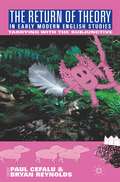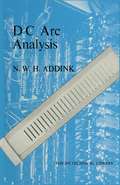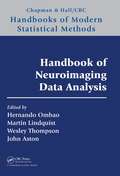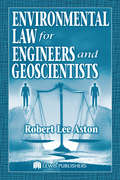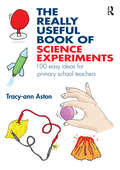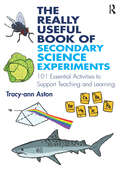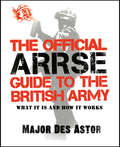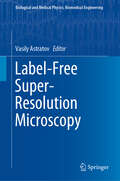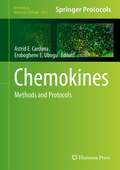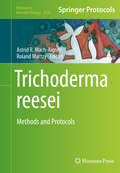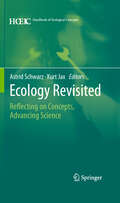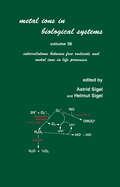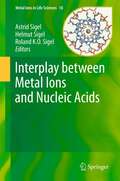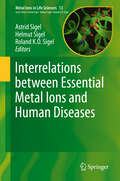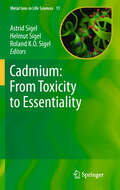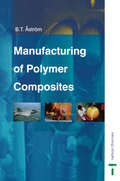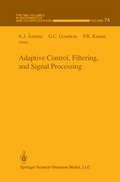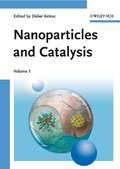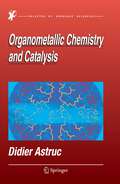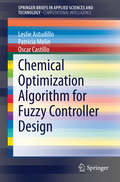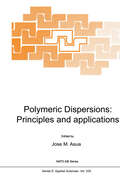- Table View
- List View
The Return of Theory in Early Modern English Studies: Tarrying with the Subjunctive
by E. Aston B. Reynolds Paul CefaluThis collection looks at the growing rapprochement between contemporary theory and early modern English literary-cultural studies. With sections on posthumanism and cognitive science, political theology, and rematerialism and performance, the essays incorporate recent theoretical inquiries into new readings of early modern texts.
Handbook of Neuroimaging Data Analysis (Chapman & Hall/CRC Handbooks of Modern Statistical Methods)
by John Aston Hernando Ombao Martin Lindquist Wesley ThompsonThis book explores various state-of-the-art aspects behind the statistical analysis of neuroimaging data. It examines the development of novel statistical approaches to model brain data. Designed for researchers in statistics, biostatistics, computer science, cognitive science, computer engineering, biomedical engineering, applied mathematics, physics, and radiology, the book can also be used as a textbook for graduate-level courses in statistics and biostatistics or as a self-study reference for Ph.D. students in statistics, biostatistics, psychology, neuroscience, and computer science.
Environmental Law for Engineers and Geoscientists
by Robert Lee AstonToday’s engineering and geoscience student needs to know more than how to design a new or remedial project or facility. Questions of law and ambiguities of terms often occur in contracts for mining, landfills, site reclamation, waste depositories, clean up sites, land leases, operating agreements, joint ventures, and other projects. Work place situations arise where environmental compliance methods are challenged by enforcement agencies. Although the statutes, rules, and regulations may seem to be worded clearly and specifically, there are often questions in application and sometimes varied interpretations. Environmental Law for Engineers and Geoscientists introduces simplified American jurisprudence focusing on the legal system, its courts, terms, phrases, administrative law, and regulation by the agencies that administer environmental law. The book comprehensively covers the “big five” environmental statutes: NEPA, CAA, CWA, CERCLA, and RCRA. With the basic law chapter as a foundation, the book covers the practical applications of environmental law for geo-engineers. It concludes with a chapter on the growing area of expert witnessing and admissible evidence in environmental litigation — an area of law where success or failure increasingly depends on the exacting preparation and presentation of expert scientific evidence. Written by a professional mining and geological engineer and a practicing attorney, Environmental Law for Engineers and Geoscientists prepares students for the numerous environmental regulatory encounters they can expect when dealing with various statutes, laws, regulations, and agency rules that govern, affect, and apply to environmental engineering projects. It provides a working knowledge of how to judge whether or not a project is in compliance with regulations, and how to ensure that it is.
Environmental Law for Engineers and Geoscientists
by Robert Lee AstonToday’s engineering and geoscience student needs to know more than how to design a new or remedial project or facility. Questions of law and ambiguities of terms often occur in contracts for mining, landfills, site reclamation, waste depositories, clean up sites, land leases, operating agreements, joint ventures, and other projects. Work place situations arise where environmental compliance methods are challenged by enforcement agencies. Although the statutes, rules, and regulations may seem to be worded clearly and specifically, there are often questions in application and sometimes varied interpretations. Environmental Law for Engineers and Geoscientists introduces simplified American jurisprudence focusing on the legal system, its courts, terms, phrases, administrative law, and regulation by the agencies that administer environmental law. The book comprehensively covers the “big five” environmental statutes: NEPA, CAA, CWA, CERCLA, and RCRA. With the basic law chapter as a foundation, the book covers the practical applications of environmental law for geo-engineers. It concludes with a chapter on the growing area of expert witnessing and admissible evidence in environmental litigation — an area of law where success or failure increasingly depends on the exacting preparation and presentation of expert scientific evidence. Written by a professional mining and geological engineer and a practicing attorney, Environmental Law for Engineers and Geoscientists prepares students for the numerous environmental regulatory encounters they can expect when dealing with various statutes, laws, regulations, and agency rules that govern, affect, and apply to environmental engineering projects. It provides a working knowledge of how to judge whether or not a project is in compliance with regulations, and how to ensure that it is.
The Really Useful Book of Science Experiments: 100 easy ideas for primary school teachers (The Really Useful)
by Tracy-ann AstonThe Really Useful Book of Science Experiments contains 100 simple-to-do science experiments that can be confidently carried out by any teacher in a primary school classroom with minimal (or no!) specialist equipment needed. The experiments in this book are broken down into easily manageable sections including: It’s alive: experiments that explore our living world, including the human body, plants, ecology and disease A material world: experiments that explore the materials that make up our world and their properties, including metals, acids and alkalis, water and elements Let’s get physical: experiments that explore physics concepts and their applications in our world, including electricity, space, engineering and construction Something a bit different: experiments that explore interesting and unusual science areas, including forensic science, marine biology and volcanology. Each experiment is accompanied by a ‘subject knowledge guide’, filling you in on the key science concepts behind the experiment. There are also suggestions for how to adapt each experiment to increase or decrease the challenge. The text does not assume a scientific background, making it incredibly accessible, and links to the new National Curriculum programme of study allow easy connections to be made to relevant learning goals. This book is an essential text for any primary school teacher, training teacher or classroom assistant looking to bring the exciting world of science alive in the classroom.
The Really Useful Book of Science Experiments: 100 easy ideas for primary school teachers (The Really Useful)
by Tracy-ann AstonThe Really Useful Book of Science Experiments contains 100 simple-to-do science experiments that can be confidently carried out by any teacher in a primary school classroom with minimal (or no!) specialist equipment needed. The experiments in this book are broken down into easily manageable sections including: It’s alive: experiments that explore our living world, including the human body, plants, ecology and disease A material world: experiments that explore the materials that make up our world and their properties, including metals, acids and alkalis, water and elements Let’s get physical: experiments that explore physics concepts and their applications in our world, including electricity, space, engineering and construction Something a bit different: experiments that explore interesting and unusual science areas, including forensic science, marine biology and volcanology. Each experiment is accompanied by a ‘subject knowledge guide’, filling you in on the key science concepts behind the experiment. There are also suggestions for how to adapt each experiment to increase or decrease the challenge. The text does not assume a scientific background, making it incredibly accessible, and links to the new National Curriculum programme of study allow easy connections to be made to relevant learning goals. This book is an essential text for any primary school teacher, training teacher or classroom assistant looking to bring the exciting world of science alive in the classroom.
The Really Useful Book of Secondary Science Experiments: 101 Essential Activities to Support Teaching and Learning (The Really Useful)
by Tracy-ann AstonHow can a potato be a battery? How quickly will a shark find you? What food should you take with you when climbing a mountain? The Really Useful Book of Secondary Science Experiments presents 101 exciting, ‘real-world’ science experiments that can be confidently carried out by any KS3 science teacher in a secondary school classroom. It offers a mix of classic experiments together with fresh ideas for investigations designed to engage students, help them see the relevance of science in their own lives and develop a passion for carrying out practical investigations. Covering biology, chemistry and physics topics, each investigation is structured as a problem-solving activity, asking engaging questions such as, ‘How can fingerprints help solve a crime?’, or ‘Can we build our own volcano?’ Background science knowledge is given for each experiment, together with learning objectives, a list of materials needed, safety and technical considerations, detailed method, ideas for data collection, advice on how to adapt the investigations for different groups of students, useful questions to ask the students and suggestions for homework. Additionally, there are ten ideas for science based projects that can be carried out over a longer period of time, utilising skills and knowledge that students will develop as they carrying out the different science investigations in the book. The Really Useful Book of Secondary Science Experiments will be an essential source of support and inspiration for all those teaching in the secondary school classroom, running science clubs and for parents looking to challenge and excite their children at home.
The Really Useful Book of Secondary Science Experiments: 101 Essential Activities to Support Teaching and Learning (The Really Useful)
by Tracy-ann AstonHow can a potato be a battery? How quickly will a shark find you? What food should you take with you when climbing a mountain? The Really Useful Book of Secondary Science Experiments presents 101 exciting, ‘real-world’ science experiments that can be confidently carried out by any KS3 science teacher in a secondary school classroom. It offers a mix of classic experiments together with fresh ideas for investigations designed to engage students, help them see the relevance of science in their own lives and develop a passion for carrying out practical investigations. Covering biology, chemistry and physics topics, each investigation is structured as a problem-solving activity, asking engaging questions such as, ‘How can fingerprints help solve a crime?’, or ‘Can we build our own volcano?’ Background science knowledge is given for each experiment, together with learning objectives, a list of materials needed, safety and technical considerations, detailed method, ideas for data collection, advice on how to adapt the investigations for different groups of students, useful questions to ask the students and suggestions for homework. Additionally, there are ten ideas for science based projects that can be carried out over a longer period of time, utilising skills and knowledge that students will develop as they carrying out the different science investigations in the book. The Really Useful Book of Secondary Science Experiments will be an essential source of support and inspiration for all those teaching in the secondary school classroom, running science clubs and for parents looking to challenge and excite their children at home.
The Official ARRSE Guide to the British Army
by Major Des AstorHow will we defeat the Taleban and bring peace to Afghanistan? What will the British soldier of the late 21st century look like? When will the next World War break out?We're damned if we know, but if you want to find out what today's British Army is really like, then The Official Arrse Guide to the British Army is the book for you. Drawn from the wit and wisdom of the ARmy Rumour Service, Britain's biggest and most active military website, the Official Arrse Guide gives the inside track on all aspects of modern British military life. How do I join? Where will I be sent? What's the hardware like? What exactly is it that clerks put in staff officers' coffee? Why do the RAF wear uniforms? Where can I get a decent pair of boots? Is there any meat in an army sausage? All these crucial questions - and more - are answered in The Official Arrse Guide.
Label-Free Super-Resolution Microscopy (Biological and Medical Physics, Biomedical Engineering)
by Vasily AstratovThis book presents the advances in super-resolution microscopy in physics and biomedical optics for nanoscale imaging. In the last decade, super-resolved fluorescence imaging has opened new horizons in improving the resolution of optical microscopes far beyond the classical diffraction limit, leading to the Nobel Prize in Chemistry in 2014. This book represents the first comprehensive review of a different type of super-resolved microscopy, which does not rely on using fluorescent markers. Such label-free super-resolution microscopy enables potentially even broader applications in life sciences and nanoscale imaging, but is much more challenging and it is based on different physical concepts and approaches. A unique feature of this book is that it combines insights into mechanisms of label-free super-resolution with a vast range of applications from fast imaging of living cells to inorganic nanostructures. This book can be used by researchers in biological and medical physics. Due to its logically organizational structure, it can be also used as a teaching tool in graduate and upper-division undergraduate-level courses devoted to super-resolved microscopy, nanoscale imaging, microscopy instrumentation, and biomedical imaging.
Chemokines: Methods and Protocols (Methods in Molecular Biology #1013)
by Astrid E. Cardona and Eroboghene E. UboguChemokines constitute a large family of structurally similar cytokines that contain a signature of conserved cysteine residues joined by disulfide bridges. Binding of chemokines to specific G protein-coupled receptors followed by downstream signaling defines their biological function. Initially, chemoattraction was the key function linked to chemokines/chemokine receptors; however, in recent years, it has become clear that chemokine ligand-receptor interactions can also modulate cellular activation, survival, and proliferation, among other functions in homeostatic and diseased states. Importantly, major advances in our understanding of chemokine biology have led to chemokine receptors becoming specific therapeutic targets with great potential. In Chemokines: Methods and Protocols, expert researchers provide practical information regarding experimental models and state of the art protocols used to delineate chemokine/chemokine receptor function and their applications in health and disease. Written in the highly successful Methods in Molecular Biology series format, chapters include introductions to their respective topics, lists of the necessary materials and reagents, step-by-step, readily reproducible laboratory protocols, and tips on troubleshooting and avoiding known pitfalls. Practical and easy to use, Chemokines: Methods and Protocols aims to reveal key protocols of functional and descriptive chemokine ligand/receptor assays that will be of practical significance to graduate students, post-doctoral fellows, trainees, and researchers in academia and industry.
Trichoderma reesei: Methods and Protocols (Methods in Molecular Biology #2234)
by Astrid R. Mach-Aigner Roland MartzyThis detailed book collects standard techniques and cutting-edge methods that are frequently used by the research community studying the fungus Trichoderma reesei. Beginning with overviews of its evolution, its use in the production of industrially-relevant enzymes, and synthetic biology applications, the volume continues with methods covering topics from transformation techniques and gene editing to downstream-analytical applications and -omics analyses and the corresponding bioinformatics approaches. Written for the highly successful Methods in Molecular Biology series, chapters include introductions to their respective topics, lists of the necessary materials and reagents, step-by-step, readily reproducible laboratory protocols, and tips on troubleshooting and avoiding known pitfalls. Authoritative and practical, Trichoderma reesei: Methods and Protocols serves as an ideal guide for a wide range of audiences, from students who want to familiarize themselves with basic research protocols to experienced scientists who are planning to establish a new method in their laboratories, working with this dynamic fungus.
Ecology Revisited: Reflecting on Concepts, Advancing Science
by Astrid Schwarz and Kurt JaxAs concerns about humankind’s relationship with the environment move inexorably up the agenda, this volume tells the story of the history of the concept of ecology itself and adds much to the historical and philosophical debate over this multifaceted discipline. The text provides readers with an overview of the theoretical, institutional and historical formation of ecological knowledge. The varied local conditions of early ecology are considered in detail, while epistemological problems that lie on the borders of ecology, such as disunity and complexity, are discussed. The book traces the various phases of the history of the concept of ecology itself, from its 19th century origins and antecedents, through the emergence of the environmental movement in the later 20th century, to the future, and how ecology might be located in the environmental science framework of the 21st century. The study of ‘ecological’ phenomena has never been confined solely to the work of researchers who consider themselves ecologists. It is rather a field of knowledge in which a plurality of practices, concepts and theories are developed. Thus, there exist numerous disciplinary subdivisions and research programmes within the field, the boundaries of which remain blurred. As a consequence, the deliberation to adequately identify the ecological field of knowledge, its epistemic and institutional setting, is still going on. This will be of central importance not only in locating ecology in the frame of 21st century environmental sciences but also for a better understanding of how nature and culture are intertwined in debates about pressing problems, such as climate change, the protection of species diversity, or the management of renewable resources.
Metal Ions in Biological Systems: Volume 36: Interrelations Between Free Radicals and Metal Ions in Life Processes
by Astrid Sigel and Helmut SigelContinues the tradition of excellence established in previous volumes in this acclaimed series. Volume 36 focuses on the vibrant research area concerning the interrelation between free radicals and metal ions and their resulting effects on life processes; it offers an authoritative and timely account of this fascinating area of research in 21 chapters.
Interplay between Metal Ions and Nucleic Acids (Metal Ions in Life Sciences #10)
by Astrid Sigel, Helmut Sigel and Roland K. O. SigelInterplay between Metal Ions and Nucleic Acids provides in an authoritative and timely manner in 12 stimulating chapters, written by 24 internationally recognized experts from 8 nations, and supported by nearly 1500 references, about 20 tables, and 125 illustrations, many in color, a most up-to-date view on metal ion-nucleic acid interactions; the characterization of which is covered in solution and in the solid state. The volume concentrates on modern developments encompassing topics in the wide range from G-quadruplexes via DNAzymes, catalysis at the DNA scaffold, and metal-mediated base pairs to peptide nucleic acids (PNAs) being thus of relevance, e.g., for chemistry and nanotechnology but also for molecular biology and (genetic) diagnostics.
Interrelations between Essential Metal Ions and Human Diseases (Metal Ions in Life Sciences #13)
by Astrid Sigel, Helmut Sigel and Roland K. O. SigelMILS-13 provides an up-to-date review on the relationships between essential metals and human diseases, covering 13 metals and 3 metalloids: The bulk metals sodium, potassium, magnesium, and calcium, plus the trace elements manganese, iron, cobalt, copper, zinc, molybdenum, and selenium, all of which are essential for life. Also covered are chromium, vanadium, nickel, silicon, and arsenic, which have been proposed as being essential for humans in the 2nd half of the last century. However, if at all, they are needed only in ultra-trace amounts, and because of their prevalence in the environment, it has been difficult to prove whether or not they are required. In any case, all these elements are toxic in higher concentrations and therefore, transport and cellular concentrations of at least the essential ones, are tightly controlled; hence, their homeostasis and role for life, including deficiency or overload, and their links to illnesses, including cancer and neurological disorders, are thoroughly discussed. Indeed, it is an old wisdom that metals are indispensable for life. Therefore, Volume 13 provides in an authoritative and timely manner in 16 stimulating chapters, written by 29 internationally recognized experts from 7 nations, and supported by more than 2750 references, and over 20 tables and 80 illustrations, many in color, a most up-to-date view on the vibrant research area of the Interrelations between Essential Metal Ions and Human Diseases.
Cadmium: From Toxicity to Essentiality (Metal Ions in Life Sciences #11)
by Astrid Sigel, Helmut Sigel and Roland KO SigelVolume 11 provides in an authoritative and timely manner in 16 stimulating chapters, written by 40 internationally recognized experts from 11 nations, and supported by more than 2600 references, 35 tables, and over 100 illustrations, many in color, a most up-to-date view on the role of cadmium for life, presently a vibrant research area. MILS-11 covers the bioinorganic chemistry of Cd(II), its biogeochemistry, anthropogenic release into the environment, and speciation in the atmosphere, waters, soils, and sediments. The analytical tools for Cd determination, its imaging in cells, and the use of 113Cd NMR to probe Zn(II) and Ca(II) proteins are summarized, as are Cd(II) interactions with nucleotides, nucleic acids, amino acids, and proteins including metallothioneins. The phytoremediation by Cd(II)-accumulating plants, etc., the toxicology of Cd(II), its damage to mammalian organs, and its role as a carcinogen for humans, are highlighted.
Manufacturing of Polymer Composites
by B. Tomas AstromThe potential application areas for polymer composites are vast. While techniques and methodologies for composites design are relatively well established, the knowledge and understanding of post-design issues lag far behind. This leads to designs and eventually composites with disappointing properties and unnecessarily high cost, thus impeding a wider industrial acceptance of polymer composites. Manufacturing of Polymer Composites completely covers pre- and post-design issues. While the book enables students to become fully comfortable with composites as a possible materials choice, it also provides sufficient knowledge about manufacturing-related issues to permit them to avoid common pitfalls and unmanufacturable designs. The book is a fully comprehensive text covering all commercially significant materials and manufacturing techniques while at the same time discussing areas of research and development that are nearing commercial reality.
Manufacturing of Polymer Composites
by B. Tomas AstromThe potential application areas for polymer composites are vast. While techniques and methodologies for composites design are relatively well established, the knowledge and understanding of post-design issues lag far behind. This leads to designs and eventually composites with disappointing properties and unnecessarily high cost, thus impeding a wider industrial acceptance of polymer composites. Manufacturing of Polymer Composites completely covers pre- and post-design issues. While the book enables students to become fully comfortable with composites as a possible materials choice, it also provides sufficient knowledge about manufacturing-related issues to permit them to avoid common pitfalls and unmanufacturable designs. The book is a fully comprehensive text covering all commercially significant materials and manufacturing techniques while at the same time discussing areas of research and development that are nearing commercial reality.
Adaptive Control, Filtering, and Signal Processing (The IMA Volumes in Mathematics and its Applications #74)
by K. J. Aström G. C. Goodwin P. R. KumarThe area of adaptive systems, which encompasses recursive identification, adaptive control, filtering, and signal processing, has been one of the most active areas of the past decade. Since adaptive controllers are fundamentally nonlinear controllers which are applied to nominally linear, possibly stochastic and time-varying systems, their theoretical analysis is usually very difficult. Nevertheless, over the past decade much fundamental progress has been made on some key questions concerning their stability, convergence, performance, and robustness. Moreover, adaptive controllers have been successfully employed in numerous practical applications, and have even entered the marketplace.
Nanoparticles and Catalysis
by Didier AstrucWritten by international experts, this monograph combines two of the most important aspects of modern chemistry, presenting the latest knowledge on these environmental friendly applications. This result is a comprehensive overview of the application of nanoparticles in catalysis, focusing on synthesis and the most important reaction types, providing all the information needed by catalytic, organic and solid state chemists, as well as those working with or on organometallics, materials scientists, and chemists in industry.
Organometallic Chemistry and Catalysis
by Didier AstrucThis volume covers both basic and advanced aspects of organometallic chemistry of all metals and catalysis. In order to present a comprehensive view of the subject, it provides broad coverage of organometallic chemistry itself. The catalysis section includes the challenging activation and fictionalization of the main classes of hydrocarbons and the industrially crucial heterogeneous catalysis. Summaries and exercises are provides at the end of each chapter, and the answers to these exercises can be found at the back of the book. Beginners in inorganic, organic and organometallic chemistry, as well as advanced scholars and chemists from academia and industry will find much value in this title.
Chemical Optimization Algorithm for Fuzzy Controller Design (SpringerBriefs in Applied Sciences and Technology)
by Leslie Astudillo Patricia Melin Oscar CastilloIn this book, a novel optimization method inspired by a paradigm from nature is introduced. The chemical reactions are used as a paradigm to propose an optimization method that simulates these natural processes. The proposed algorithm is described in detail and then a set of typical complex benchmark functions is used to evaluate the performance of the algorithm. Simulation results show that the proposed optimization algorithm can outperform other methods in a set of benchmark functions.This chemical reaction optimization paradigm is also applied to solve the tracking problem for the dynamic model of a unicycle mobile robot by integrating a kinematic and a torque controller based on fuzzy logic theory. Computer simulations are presented confirming that this optimization paradigm is able to outperform other optimization techniques applied to this particular robot application.
Polymeric Dispersions: Principles and Applications (NATO Science Series E: #335)
by J. M. AsuaA comprehensive and up to date survey of the science and technology of polymeric dispersions. The book discusses the kinetics and mechanisms of polymerization in dispersed media, examines the processes controlling particle morphology, presents both off-line and on-line methods for the characterization of polymer colloids, considers reactor engineering and control, and covers a wide variety of applications, such as latex paint formulations, encapsulation of inorganic particles, reactive latexes, adhesives, paper coating, and biomedical and pharmaceutical applications. Audience: A valuable resource for scientists and engineers, academic and industrial, who are involved in the manufacture or application of polymeric dispersions.
